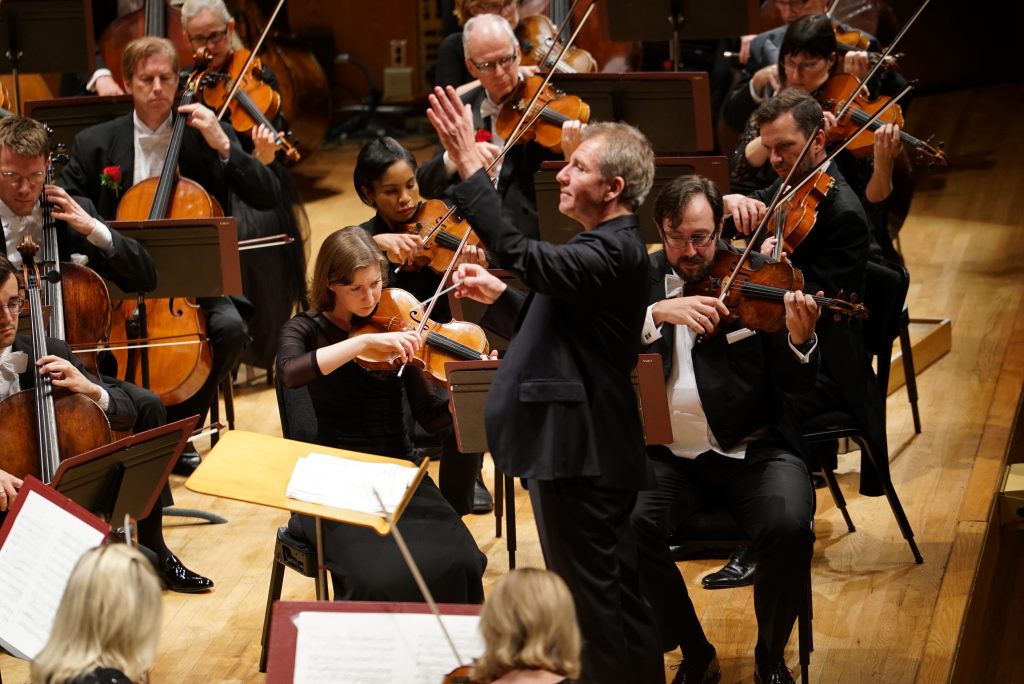The Utah Symphony’s Fischer era concludes with rich and radiant Mahler

Among the many qualities Salt Lake City audiences should remember about Thierry Fischer is his ability to play to his strengths.
For his final program as music director of the Utah Symphony, the Swiss conductor chose Mahler’s Symphony No. 3—a vast, six-movement work featuring a mezzo-soprano soloist and choir, which ends with an exquisite Adagio.
It is rare for a symphony to end with a slow movement—though Mahler also does so in his Ninth. The gradual crescendos, contrapuntal textures, string swells, and subtly shifting colors in the finale seem tailormade to showcase the orchestra’s unique strengths, which have been cultivated under Fischer’s 14-year tenure.
The orchestra was clearly in synch from Fischer’s downbeat Friday night at Abravanel Hall, acquitting itself well in the dramatic first movement. Spanning over a third of the 100-minute length, it nearly stands alone as a complete musical journey.
Mahler gave each movement a programmatic title, which he did not publish at the premiere, but which, nonetheless, has persevered. The first movement,“Pan awakes—Summer marches in” begins with a martial fanfare in the horns, then descends into a dark, primordial procession over a rumble in the low brass and bass drum. Light shines through in a sweet pastoral theme in the violins and winds, and though the darkness returns, it is eventually overtaken by a frenzied triumph that is a staple of Mahler symphonies.
With crisp attacks, dramatic pauses, and free, organic tempi, Fischer and the orchestra accentuated the opening movement’s drama and contrast. The strings and winds entered with a gorgeous blend and conscientious phrasing that set the stage for the first of several exquisite solo passages by concertmaster Madeline Adkins. Principal Trombonist Mark Davidson had a similarly starring role, and he gave his solos the expressive qualities of an operatic baritone. With a rich, warm tone, he lent a sense of longing to the movement’s more wistful passages. Fischer and the orchestra plotted the movement’s emotional journey with great skill, building to an intense, jubilant climax, and highlighting the full spectrum of Mahler’s character.
The second and third movements (“What the flowers in the meadow tell me” and “What the animals in the forest tell me) are smaller in emotional scope and more intimate, presenting a graceful minuet followed by a spritely romp. Principal oboe Zac Hammond led off the second with an expressively phrased solo passage, and the orchestra danced gracefully along, with refined phrasing and a lovely balance.
Principal trumpeter Travis Peterson exited the stage after the second movement and spent most of the third movement playing from the wing, giving his solo passages a warm soulful sound that contrasted with the brighter, more brilliant tone from his onstage colleagues.
The tone shifts from whimsical to mournful for the introspective, existential fourth movement, “What man tells me.” Soloist Anna Larsson, met the moment beautifully, the Swedish mezzo-soprano’s full voice, and clear tone filling the hall and giving weight and import to the lines “Oh Man! Deep is his Woe!” The orchestra created a sublime backdrop for this meditation, with gorgeously phrased solo passages by Adkins and Hammond.
“What the angels tell me,” the fifth movement, begins with a joyful chorus from the women’s and children’s choir, but the soloist still needs convincing that Man’s redemption and joy is possible, and the musical drama arises out of that struggle. From the outset, the Choristers of the Madeline Choir School and the women of the Tabernacle Choir at Temple Square created an angelic sound, rising and falling with the orchestra and encapsulating the “heavenly bliss” in the text. When Larsson entered again with her existential questioning, the contrast between “man” and “angel” was clear.
Beginning in the strings with a quiet, stately dignity, the concluding Adagio (“What love tells me”) grew organically under Fischer’s careful direction, with attention paid to each contrapuntal line as well as the overall architecture. The movement appeared to be one continuous phrase as it moved through Mahler’s modulations and motivic development, highlighting the textures and colors created by his rich orchestration. As the music reached its climax, Fischer seemed to wring every possible bit of sound and emotion out of the orchestra.
During the extended standing ovation, a super-title banner read “Thank you Thierry,” signaling the end of a happy and artistically important era for the Utah Symphony.
The program will be repeated 7:30 p.m.Saturday. utahsymphony.org

